Although they are only small bridges across
the rivers but thanks to special architecture, ancient beauty; The covered
bridges that feature typical beauty of each land of the country, and also the
works bearing the national cultural identity.
 Covered bridge of Thay pagoda
Covered bridge of Thay pagoda
1. Covered bridge of Thay pagoda
In the architectural features that make up the characteristic of Thay pagoda
(Sai Son commune, Quoc Oai district, Hanoi), it is impossible not to mention two
ancient covered bridges of Nhat Tien and Nguyet Tien. These two bridges are
located on either side of the front yard of the pagoda, in which Nhat Tien
bridge connects the pagoda to a small island, on the island there is Tam phu
temple.
According to historical records, these two bridges were built by Phung Khac
Khoan at the beginning of the 17th century, after the trip to China.
Legend has it that Phung Khac Khoan used feng shui art to explain that Thay
pagoda was built on the dragon's forehead, Nhat Tien and Nguyen Tien bridges
have curved shape, which is a pair of dragon eyelids. Overall, the two bridges
were built under Thuong Gia Ta Kieu architecture (house on the upper, bridge
under), each bridge consists of 5 spaces, under the construction of rolling
stone on the construction of wooden house frames with tiles.
On both sides of an open bridge, there is a low railing that is widened to serve
as a resting place for the guests. Before each bridge, there were a pair of
ancient stone dragons.
The covered bridge, which is a popular architecture of villages, is rarely
present in the temples of the ancient Vietnamese. Therefore, the appearance in a
Buddhist space has brought special to two tile bridges of Thay Pagoda.
The naming of the bridge based on the symbol of Japan - Nguyet (sun, moon) also
means that the two civets symbolizing the two sides of Yin and Yang harmonize to
create a balance for heaven and earth and all things.
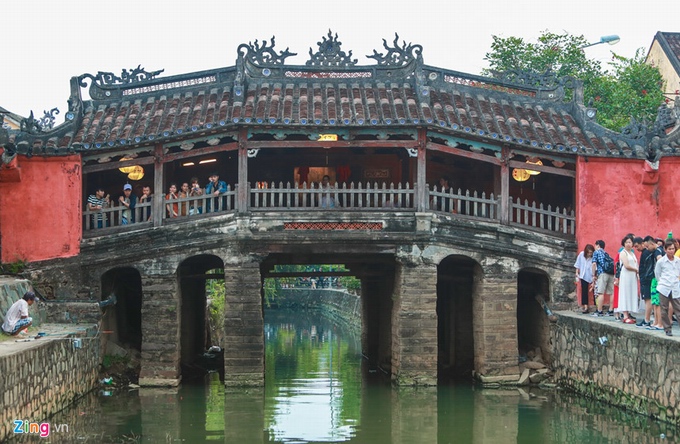 Hoi An Covered Bridge
Hoi An Covered Bridge
2. Hoi An Covered Bridge
Hoi An covered bridge or Chua Cau was chosen as the symbol of Hoi An city,
appearing on the 20,000 Vietnam Dong bank note. This bridge was built by
Japanese merchants who came trading in Vietnam in the 17th century. The bridge
is about 18m long, squeezed through a stream flowing into Thu Bon River.
The mark of Phu Tang culture on the bridge shows in the animal statue at the
ends of the bridge, one end is a dog statue, one is a monkey statue. On the main
door of Chua Cau, there is a large sign that touches 3 Chinese characters called
Lai Vien Kieu (meaning the bridge of far-flung friends). The middle part (called
the pagoda) worships a wooden statue of the North Emperor Tran Vo - the god of
protection of the country, who specializes in handling floods, giving happiness
to people.
The Cau Pagoda was chosen as a symbol of
Hoi An city.
Along with the time, the architecture of the Cau Pagoda is a Vietnamese style
with the roof of the yin and yang tiles covering the bridge.
cheap tours to Vietnam
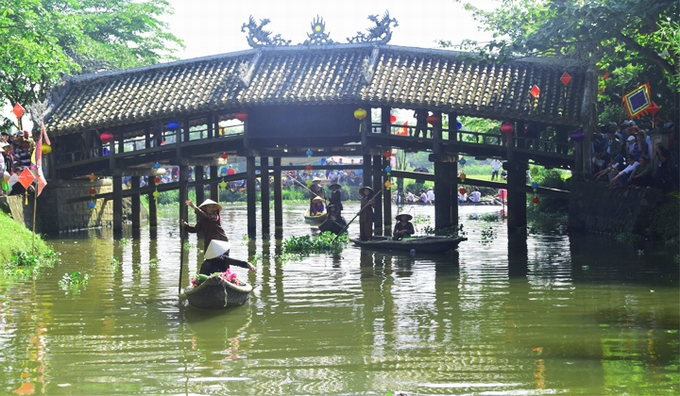 Thanh Toan covered bridge
Thanh Toan covered bridge
3. Thanh Toan covered bridge
Thanh Toan tile bridge is about 8 km southeast of Hue city in Thuy Thanh
commune, Huong Thuy district.The bridge is designed in the style of "house on
the upper, bridge under”. The body of the bridge is made of wood, on top of a
glazed tile roof.
Like Hoi An Bridge Pagoda, Thanh Toan covered bridge is divided into sections,
each as a small room in a big house. The bridge is about 17 m long, 4 m wide and
is divided into 7 sections with the middle space where worshiping Madam Tran Thi
Dao - who contributed money to build bridges for the villagers to make their way
back and forth in the 18th century.
Thanh Toan tile bridge is one of the bridges that belong to the rare and high
artistic value in Vietnam.
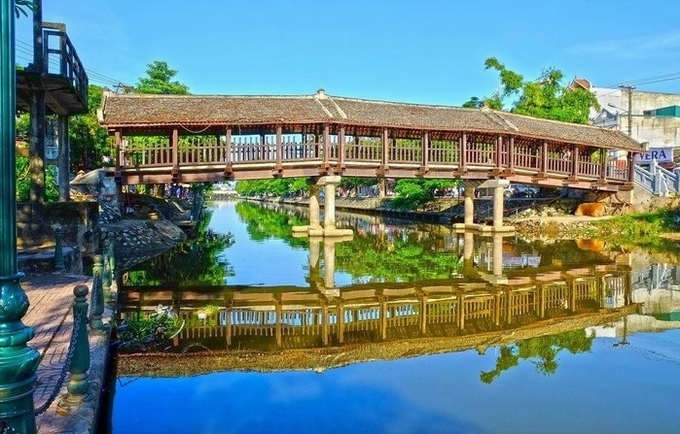 Phat Diem covered bridge
Phat Diem covered bridge
4. Phat Diem covered bridge
Phat Diem covered bridge was built across the An river and is located in the
center of Phat Diem town, Kim Son district, about 30 km from
Ninh Binh city.
The bridge is shaped like a rainbow, the roof is covered with tiles, on both
sides are two rows of wooden pillars, and the solid woods are very strong
railing. The bridge has 3 spans, each with 4 sections. The length of this bridge
is 36m, the width is 3m. On the two sides of the bridge there are steps, only
pedestrians can cross the bridge. The roof of the brided is covered traditional
red tiles of the Northern Delta region.
Compared with Hoi An Bridge Pagoda and Thanh Toan tile bridge, Phat Diem covered
bridge has a gentle and serene appearance, reflecting the special creative
talent of Catholics. This is considered a rare bridge and has the highest
artistic value in all kinds of ancient bridges in Vietnam. The bridge has both
transport function and an ancient house, moreover, it
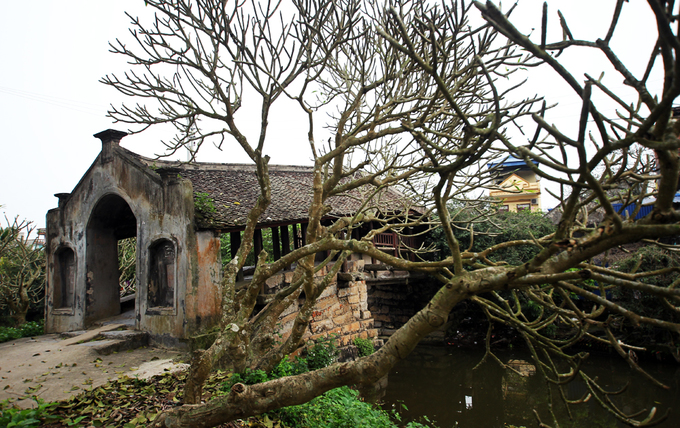 Thuong market covered bridge
Thuong market covered bridge
5. Thuong market covered bridge
Thuong market covered bridge is in Thuong Nong village, Binh Minh commune, Nam
Truc district, Nam Dinh province. The bridge was built over Ngoc river next to
Thuong market and was be called Thuong market covered bridge. The bridge was
built in the 18th century thanks to the merit of Mrs. Nguyen Thi Ngoc Xuan –
concubine of the Trinh lord, she was from Thuong Nong village.
The bridge structure is quite unique, the upper part with wooden frames and a
covered roof, the south and north gates are built of 2m high with bricks; both
sides of the bridge has words "Thuong gia kiều" (Upper House bridge) in Chinese
characters. The bridge basement was built entirely of stone blocks firmly
located on the banks of the Ngoc River. Thanks to the strong pedestal, for more
than 300 years with many historical changes, the bridge still stands.
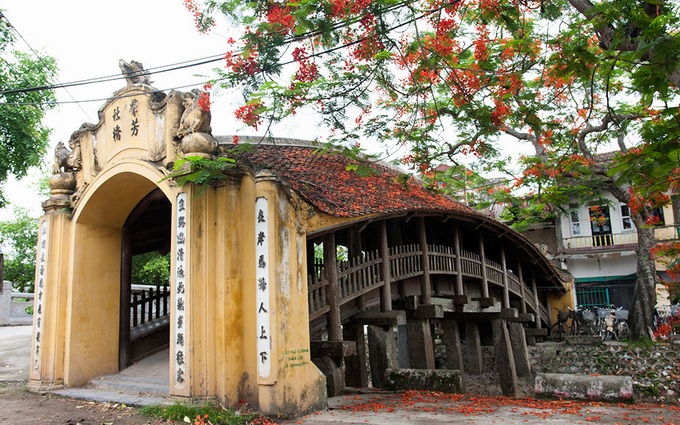 Covered bridge of Luong pagoda
Covered bridge of Luong pagoda
6. Covered bridge of Luong pagoda
Also in Nam Dinh, the bridge of Luong pagoda is located in Hai Anh commune, Hai
Hau district, across Hoanh river, more than 100m from Luong temple. The bridge
of Luong pagoda is located in the cluster of historical-cultural relics "Luong
pagoda, Covered bridge and Phong Lac temples" famous for the ancient Quan Anh
land.
The structure inside the bridge is simple but firm, the bridge has 9 bends like
rainbow on 18 strong rock pillars. On the stone pillar is a system of horizontal
bars to support the beams. The bridge floor is designed as two distinct parts.
The bed of of the bridge is 2m wide, consisting of many lumberwood bars located
on the row of bended beams, and there are many shorter woods with rounded edges
to create steps for pedestrians to climb up and down. The two sides of the
bridge are curved corridors so that pedestrians can stop to sit and rest, the
outside of the corridor is a wooden railing.